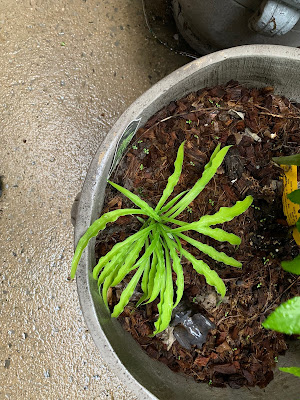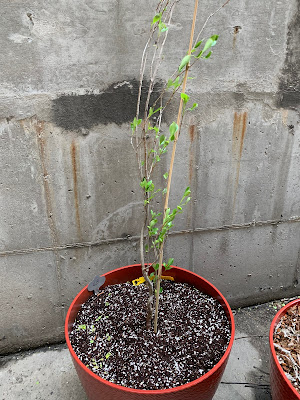Pot 15 -I've always loved this pot. When I first started container gardening, I read about "The Thriller, the Spiller, and the Filler," meaning that each pot should have something tall and dramatic, something that spills over the sides, and something that fills in the rest of the space. I'm not sure how useful this rule is. I tried it out only in a few pots, and they're all in the section I'm writing about today.
Wheeee!, purchased in 2017;
and American Halo, purchased in 2018.
The entire pot is thriving. Also, please forgive that all the photos are sideways!
Pot 16 is empty.
Pot 17 has a Berry Heavy winterberry holly. Thriving, but not yet blooming. Also sideways.
Pot 18 has the new Upright Japanese Yew as Thriller, more ivy as Spiller (ivy is excellent at spilling), and the Ghost Lady Fern (purchased from Wayside Gardens in 2016) as Filler. All thriving.
The Ghost Lady always looks dead in the wintertime, but then just explodes into fluffy ferny-ness every April.
Pot 19 has the Prince William Serviceberry as Thriller.
I bought the Prince William Serviceberry in spring 2016, when I was still under the delusion that flowering trees would bloom in my garden. Prince William has never bloomed, of course, because trees need sunlight to bloom. Most years, he has some kind of rusty-looking spots on his leaves, but so far this year, he hasn't succumbed to whatever blight that is. He's a sad little tree who doesn't grow much, and he's not much of a Thriller, but I'm fond of him.
The Spiller is the Creeping Jenny, which at the moment is just ground cover but which may droop over the sides of the pot as the season progresses. (Creeping Jenny is invasive, so it's fine in containers but could be a terror in a regular garden.) And for Filler, I have a Key West hosta (2017) and a Marmalade Lime heuchera (split off in 2018 from the plant in pot 26). I don't know what possessed me to put all these lime-green plants in one pot, but they do look kind of nice together.
Pot 20 is a Dwarf Alberta Spruce that I got cheap at Whole Foods after Christmas 2017. It's putting out a lot of new needles, which is nice.
Pot 21 is the Cathedral Windows hosta, purchased last summer at Van Wilgen's in Connecticut. It's not growing as quickly as most of my other hostas, but it's surviving, at least.
Pot 22 is also a Van Wilgen's plant - the Christmas fern. It's coming back in a small way, so surviving but not thriving.
Pot 23 has another of those self-seeded oak trees, but it's got lots of little leaves! It's still tiny, but this is definitely my mightiest oak. Also in the pot: more ivy (it's cheap and easy to grow) and a Redstone Falls heucherella, split off last year from the one in Pot 6.
Pot 24 is a windowbox with three hostas: Restless Sea (Agway, Connecticut, 2018); Electrocution (2017); and Pilgrim (not sure of the year). Restless Sea is kind of taking over the universe here.
Pot 25 is the other windowbox, with Stained Glass hostas that I purchased bare-root from Home Depot in 2016.
And finally, Pot 26, with a Lime Marmalade heuchera that I bought in Connecticut in 2018.
And that's the garden!























































